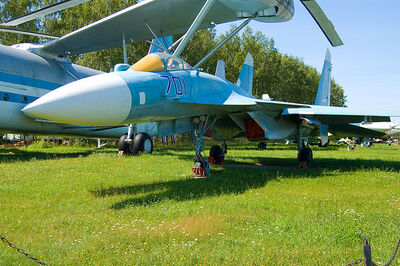
The Su-33 (Super) Flanker ( is often switched with the Su-35 BM, but both are different aircraft) is a Soviet air superiority fighter, that has never entered service. It is a related development of the Su-27S.
Development[]
Even before the Su-27 Flanker entered service, the Sukhoi engineers thought to develop a whole Flanker family of aircraft. This aircraft family should be composed of a Long-range interceptor, an Air-superiority fighter, a Fighter-bomber and a Multirole aircraft.
Development of the Super Flanker (at first called Su-27M or T-10) began in 1984; so that the first flight of one (T-10M-1) of 10 prototypes was on 28th June 1988. The first public appearance ( the T-10M-3; third prototype) was at the Farnborough International Airshow in 1992. It was a completely redesigned aircraft.

The difference between the Super Flanker and it´s precursors are the Canards and the enlarged Radome. The Super Flanker was designed to be very manoeuvreable. Because the the static stability of the Su-27 Flanker was removed and a fly-by-wire system was included, the manoeuvreability was greatly enhanced. In combination with the canards, the aircraft became much more agile than the static stable Su-27 Flanker. The dry thrust of the Su-35 was also increased, but not high enough to give it the ability to Suercruise. Fuel consumption of the engines was lowered as well, but it was still higher than on the American and European fighter aircraft. The angle of attack was increased to 30 degrees and because of the use of composite materials and Aluminium-lithium alloys the weight could be hold at acceptable limits.
In the greatly enlarged Randome the N-011 radar was monted, which is able to track a 3 m² target at 160 km. It is able to track 20 targets and to fight against six of them. The Super Flanker is also equipped with a second radar monted on its tail, with a range up to 50 km. On the wingtips of the aircraft ECM-systems are monted.
Ten single seat Su-35 prototypes and two twin-seat Su-35UB trainer aircraft were built. An eleventh prototype (T-10M-11) was equipped with 3D thrust vectoring and was called Sukhoi Su-37 Terminator.